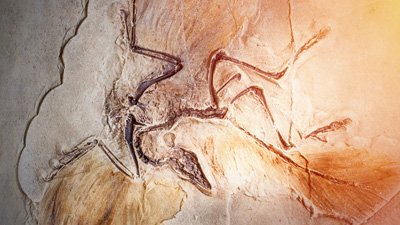
Researchers Devise Alternate Theory For Cambrian Explosion
Cambrian secrets of small beginnings
News Source
Darwin was troubled by the sudden appearance of multicellular organisms “in the lowest known fossiliferous rocks”—the Cambrian explosion. He “argued that the incompleteness of the fossil record gives the illusion of an explosive event, but with the eventual discovery of older and better-preserved rocks, the ancestors of these Cambrian taxa would be found.”1 Since the fossil record has failed to provide sufficient ancestral forms, the magical world of mathematics has stepped in to fill the gap, giving new significance to Precambrian microfossils.
In Darwin’s view, Precambrian rocks contained no fossils. Evolutionary scientists have not thought that the Precambrian microfossils discovered since Darwin’s day are ancestrally sufficient to explain the diverse multitude of Cambrian creatures. Because evolutionists believe life evolved in a series of small steps over millions of years, the missing ancestors represent a real conundrum.
An international team of researchers has been crunching numbers from both paleontology and molecular genetics to solve this age-old mystery. They say they’ve found the secret of the Cambrian “illusion.”
Using a divide-and-conquer approach, half of these paleo-detectives analyzed the “precise temporal framework”2 of the fossil record while the other half collated data drawn from a “rigorous understanding of the phylogenetic relationships”3 between extant and fossilized organisms and “their dates of origin.”4 When they compared notes, they found “the basic genetic components for the organisms that seemingly sprang into existence during the Cambrian period were in place long before the fossil records show.” They calculated these genes got the jump on the Cambrian fossils by 200 million years.
And where were these genes lurking? In those Precambrian microfossils! “The unavoidable conclusion from the molecular record is that precambrian animals are largely stem lineages leading to extant phyla.”5 This “macroevolutionary lag”,6 they write, lasted until ecological conditions adjusted to the influences these primordial life-forms were having on the earth and also until regulatory genes could evolve. Since similar protein molecules appear in multiple organisms, the researchers believe regulatory genes to individualize protein expression had to evolve just prior to the evolution of diverse multicellular life-forms.
The only way to distinguish “evolutionary origins from geological first appearances . . . is to use a molecular clock,”7 the team writes. While asserting the molecular clock distinguishes between the two halves of “the fossils-and-genes crowd,” both groups are really using information built on the same assumptions. The results, therefore, give the illusion of remarkable precision in their correlation of data, but those data consist of numbers all drawn from the same source. What the researchers have built is an elaborate system of statistical circular reasoning.
A 2004 study published in Trends in Genetics details how molecular clocks offer an “illusion of precision . . . achieved mainly through the conversion of statistical estimates (which by definition possess standard errors, ranges, and confidence intervals) into errorless numbers. By employing such techniques successively, the time estimates of even the most ancient divergence events were made to look deceptively precise.”8 The product of such molecular clock calculations has been “an exhaustive evolutionary timeline that is enticing but totally imaginary.” 9
Even if those dating assumptions were true, “no geological dating is without error.”
Molecular clocks, built on the assumption that mutation rates have remained constant, are correlated with radiometric dating methods. In fact, they actually hinge on “a single calibration point that has been unjustly denuded of error.”10 Such methods do not provide the promised “precise temporal framework.” Instead, they are built on unverifiable uniformitarian assumptions that ignore changes in earth’s history, particularly the catastrophic influence of the global Flood on geology. And even if those dating assumptions were true, “no geological dating is without error.”11 Statistical mismanagement of such dates has built a molecular clock database on shaky sand.
Furthermore, the demand for evolutionary ancestors assumes that one kind of organism can accumulate information through mutations and evolve into another kind of organism. However, mutations involve a loss of information. Indeed, a 2010 study in Trends in Genetics points out that “most studies of recent evolution involve the loss of traits, and we still understand little of the genetic changes needed in the origin of novel traits.”12
Since this secret to the Cambrian mystery is the real illusion, we need to look elsewhere to explain the sudden change between the Precambrian and Cambrian rocks. The answer is in Genesis. God created all kinds of living things during Creation Week and designed each to reproduce after its kind, not to evolve into new kinds. Most creationist geologists believe the Precambrian rock layers were present prior to the global Flood. The upheavals of the Flood then buried countless marine invertebrates as the first impact of God’s catastrophic judgment, trapping them in the sediments now making up the Cambrian layers. The secret of the Cambrian explosion has been available in the Bible all along.
Further Reading
For More Information: Get Answers
Remember, if you see a news story that might merit some attention, let us know about it! (Note: if the story originates from the Associated Press, FOX News, MSNBC, the New York Times, or another major national media outlet, we will most likely have already heard about it.) And thanks to all of our readers who have submitted great news tips to us. If you didn’t catch all the latest News to Know, why not take a look to see what you’ve missed?
(Please note that links will take you directly to the source. Answers in Genesis is not responsible for content on the websites to which we refer. For more information, please see our Privacy Policy.)
Footnotes
- D. Erwin, “The Cambrian Conundrum: Early Divergence and Later Ecological Success in the Early History of Animals,” Science 334, no. 6059:1091–1097, http://www.sciencemag.org/content/334/6059/1091.
- Ibid.
- Ibid.
- Ibid.
- Ibid.
- Ibid.
- Ibid.
- D. Graur and W. Martin, “Reading the Entrails of Chickens: Molecular Timescales of Evolution and the Illusion of Precision,” Trends in Genetics 20, no. 2 (February 2004): 80–86, http://www.cell.com/trends/genetics/abstract/S0168-9525(03)00342-1.
- Ibid
- Ibid
- Ibid
- https://www.cell.com/trends/genetics/fulltext/S0168-9525(10)00168-X
Recommended Resources

Answers in Genesis is an apologetics ministry, dedicated to helping Christians defend their faith and proclaim the good news of Jesus Christ.
- Customer Service 800.778.3390
- © 2025 Answers in Genesis







